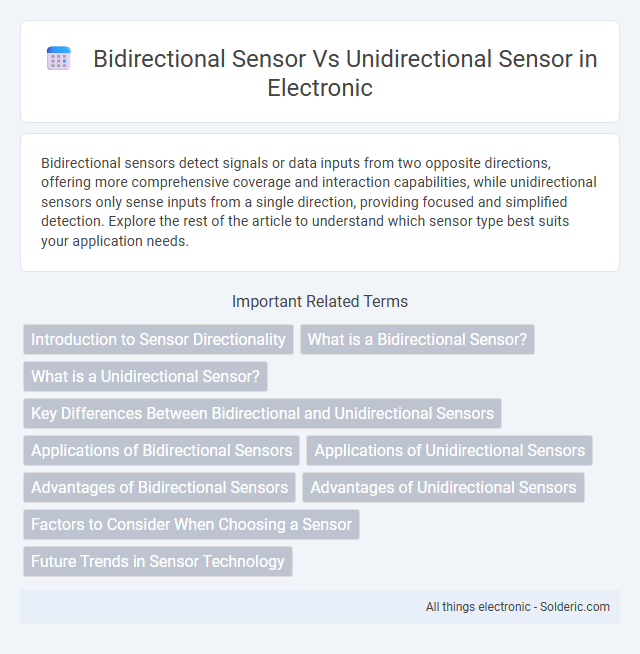Bidirectional sensors detect signals or data inputs from two opposite directions, offering more comprehensive coverage and interaction capabilities, while unidirectional sensors only sense inputs from a single direction, providing focused and simplified detection. Explore the rest of the article to understand which sensor type best suits your application needs.
Comparison Table
| Feature | Bidirectional Sensor | Unidirectional Sensor |
|---|---|---|
| Signal Detection | Detects signals in two directions | Detects signals in one direction only |
| Application | Used in systems requiring two-way communication or monitoring | Used in systems with one-way signal flow |
| Complexity | Higher due to dual-direction detection | Simpler design focused on single direction |
| Cost | Generally more expensive | More cost-effective |
| Example Use Cases | Networking equipment, full-duplex communication | Motion detectors, single-direction flow measurement |
| Accuracy | Accurate for bidirectional signals | Optimized for unidirectional signals |
| Power Consumption | Typically higher due to advanced processing | Lower, simpler operation |
Introduction to Sensor Directionality
Sensor directionality determines how signals are transmitted and received, with unidirectional sensors detecting stimuli from a single direction and bidirectional sensors capable of sensing in two opposite directions. Understanding this distinction is crucial for optimizing your system's accuracy and performance in applications like motion detection, sound capture, and environmental monitoring. Choosing the right sensor directionality enhances data precision and ensures better responsiveness in your technology setup.
What is a Bidirectional Sensor?
A bidirectional sensor detects and measures signals or data in two opposite directions, enabling it to capture information from both sides of its sensing area. Unlike unidirectional sensors, which only sense in a single direction, bidirectional sensors provide enhanced monitoring capabilities for applications requiring comprehensive spatial awareness. These sensors are commonly used in robotics, automation, and safety systems to improve accuracy and responsiveness.
What is a Unidirectional Sensor?
A unidirectional sensor detects signals or changes from a single direction, allowing precise monitoring in one specific area. It is designed to capture data such as motion, light, or sound coming only from the front or a targeted zone, minimizing interference from other directions. Your system can benefit from unidirectional sensors when focused, accurate detection is required in environments with directional stimuli.
Key Differences Between Bidirectional and Unidirectional Sensors
Bidirectional sensors detect signals or data transmission in two opposite directions, enabling real-time feedback and comprehensive monitoring, while unidirectional sensors measure in only one direction, limiting the scope of data acquisition. The key differences lie in their operational functionality: bidirectional sensors facilitate dynamic interaction and adaptive responses, making them suitable for applications like robotics and communication systems, whereas unidirectional sensors provide simpler, single-directional data for tasks such as motion detection or environmental monitoring. Performance efficiency varies as bidirectional sensors typically exhibit increased complexity and cost due to dual-direction processing, compared to the straightforward design and lower expense of unidirectional sensors.
Applications of Bidirectional Sensors
Bidirectional sensors are widely used in applications where detecting motion or signals in two opposite directions is crucial, such as in automated conveyor systems, robotic arms, and industrial safety equipment. These sensors enable precise control and monitoring by capturing data from both inbound and outbound movements, improving operational accuracy and safety. Your systems can benefit from enhanced feedback and responsiveness by integrating bidirectional sensors in environments requiring real-time directional detection.
Applications of Unidirectional Sensors
Unidirectional sensors are commonly used in applications that require detection or measurement from a single direction, such as motion detection in security systems, industrial automation, and object counting on conveyor belts. These sensors provide precise and focused data, making them ideal for environments where interference from other directions must be minimized. Your systems benefit from enhanced accuracy and reliability when unidirectional sensors are employed in targeted monitoring and control tasks.
Advantages of Bidirectional Sensors
Bidirectional sensors provide enhanced data accuracy by detecting signals or changes in both directions, enabling more comprehensive monitoring and control compared to unidirectional sensors limited to a single direction. These sensors improve system responsiveness and reliability in applications such as robotics, automation, and communication by offering real-time feedback and increased sensitivity. The ability to capture reverse signals or movements reduces errors and supports complex processes requiring dynamic interaction and precise measurements.
Advantages of Unidirectional Sensors
Unidirectional sensors offer superior accuracy and noise reduction by detecting signals from a single direction, which enhances signal clarity and minimizes interference. These sensors are ideal for applications requiring precise monitoring within a defined area, ensuring reliable data collection. You benefit from improved performance in environments with high background noise or multiple signal sources due to their focused detection capability.
Factors to Consider When Choosing a Sensor
When choosing between bidirectional and unidirectional sensors, key factors include the directionality of signal transmission, operational environment, and application requirements. Bidirectional sensors offer two-way communication, making them ideal for systems requiring feedback or control from both ends, while unidirectional sensors transmit signals in a single direction, suited for simpler detection tasks. Sensitivity, range, power consumption, and interference resistance also influence the choice, depending on the specific industrial, automation, or monitoring context.
Future Trends in Sensor Technology
Bidirectional sensors are increasingly integrated with advanced data analytics and IoT platforms, enabling real-time two-way communication and enhanced environmental adaptability. Unidirectional sensors continue to evolve with improved sensitivity and lower power consumption, particularly in applications requiring straightforward data transmission. Future trends emphasize hybrid sensor systems that combine bidirectional communication capabilities with the simplicity of unidirectional designs to optimize performance in smart manufacturing, autonomous vehicles, and healthcare monitoring.
Bidirectional sensor vs unidirectional sensor Infographic

 solderic.com
solderic.com